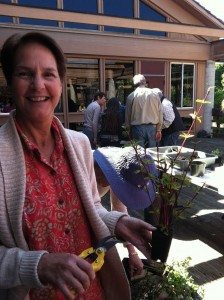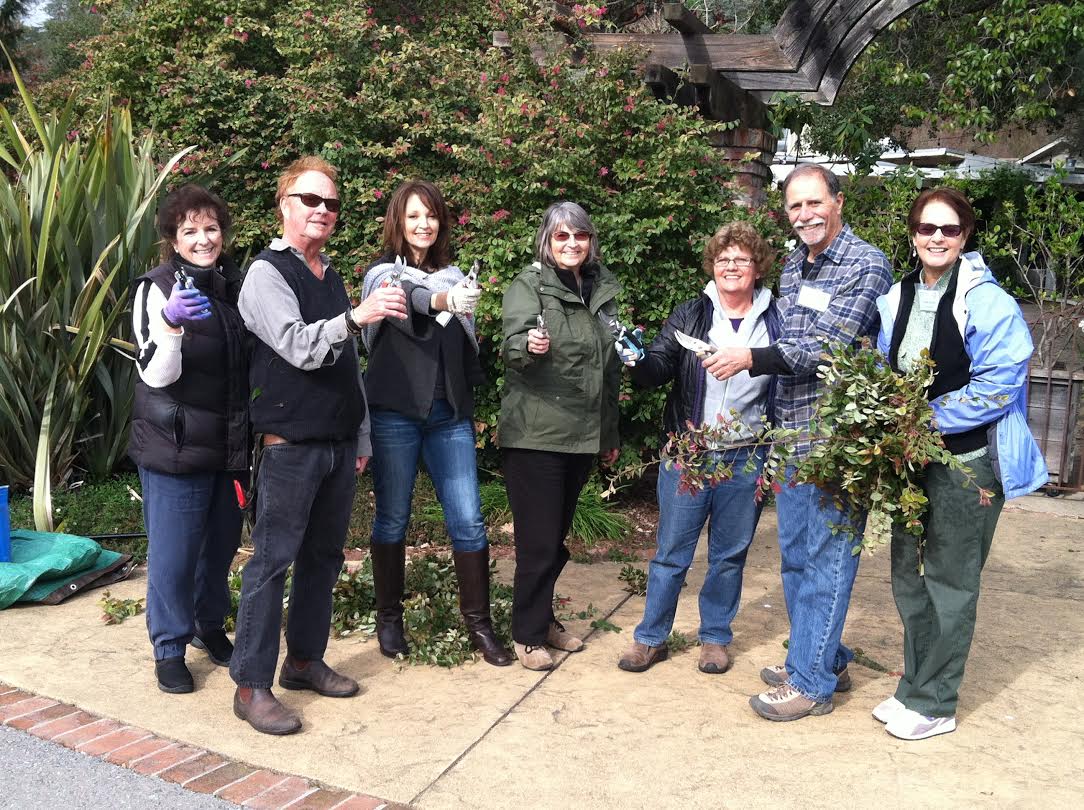By Lily O’ Brien
Those who love gardening might just call Marin Nirvana. With a moderate climate year-round and plenty of open space, the county provides practically unlimited opportunities for planting, pruning and picking everything from succulent fruits to leafy vegetables to fragrant flowers. And for people who really want to dig in, there’s Marin Master Gardeners (MMG).
Marin Master Gardeners—a group of more than 300 trained gardening volunteers who share their green thumb skills with community organizations and the general public—is part of the University of California Cooperative Extension (UCCE). In 1980, the first University of California pilot program was launched in Riverside and Sacramento counties, and Marin Master Gardeners was created in 1986. There are now programs in more than 40 counties in California, in all 50 states and in four provinces in Canada.
Becoming a Marin Master Gardener requires a huge commitment. The 18-week course (taught by University of California faculty and staff) is presented on Thursdays (for six hours) from January through mid-May. The only actual requirements are that applicants are Marin residents, have a passion for gardening and are interested in community service.
The course is offered at the Indian Valley Campus of College of Marin, and includes classes, lectures and field trips, and in the first year MMGs are required to complete at least 50 hours of MMG-sponsored volunteer service (including working at their help desk, at their demonstration gardens and at farmers’ markets), and 12 hours of continuing education. To maintain MMG certification, every year thereafter, Master Gardeners are required to complete 25 volunteer hours and 12 continuing education credits. Definitely not for the faint of trowel!
May 7 was graduation day for the 2015 class of Marin Master Gardeners. After the ceremony, I sat down for coffee with Judy Orsini, one of the graduates from the new “crop” of Master Gardeners and one of her teachers, Pat Randolph, who is a co-president of the organization and a graduate of the 2009 class. Both women are retired from positions at UCSF, and were enthusiastic about being Marin Master Gardeners.
* * * * *
Why did you want to become a Master Gardener?

Judy Orsini: I wanted to become familiar with more plants and frankly, I kept having plants die in my yard and I didn’t understand why and I wanted to be able to care properly for my plants. And then also because I live on the north-facing hillside in Mill Valley and I can’t grow a very good vegetable garden. I am also interested in getting involved with some of the community gardens where I can get some satisfaction from growing edibles, but not necessarily for myself.
Pat Randolph: After I retired I asked myself, “What do I want to do with the next phase of my life? This appealed to me because it was a way to keep learning and a way to be useful to people, and I love being in the garden.”
Becoming a Marin Master Gardener is such a huge commitment. Why not just read a few books instead?
Orsini: There are four textbooks and they are 5-1/2 inches tall—I measured them [she laughs]. But there’s more to it than just learning. You are increasing your knowledge about plants and soil and irrigation and propagation and pruning—it’s very comprehensive, and the community service is another aspect to it. I am retired now, and I want to spend my time doing something that is valuable, and giving to the community, but also making new friends—that is a big part of it—the socialization; making friends who share this common interest in gardening and volunteering.
Randolph: One of the beauties of the program to me is that you get to know a wide variety of people from all over the county and all different walks of life and it is just kind of wonderfully fun.
What do you actually do in the classes?
Orsini: There [are] usually, on average, three lectures over the course of the day. And we often went out into the field and observed various things at the Indian Valley campus. We helped in the organic garden there, and also volunteered for Farm Day at the civic center to introduce school children to agriculture.
Given the huge time commitment, are people in the classes mostly retired?
Randolph: The majority are retired but we do have a surprising number of young mothers whose kids are still school age. Back in 2008-2009 we had several very young people who had never even had their first job, and it didn’t work out really well because as soon as they got hired for their first job they no longer had time for MMG.
Orsini: It is time consuming. There were a couple of them (younger people) and it was tough on them. And some employers let people off every Thursday so they could do the program, but it would be hard if you worked full-time. There is probably eight hours of homework every week during the training.
What do people do at the help desk?
Orsini: People walk in, call or send emails and say, ‘I’ve got this diseased leaf—what’s wrong with it?’ Or maybe they want to replace their lawn with drought-tolerant plants and want to know what we would recommend. And crazy questions like, ‘I got a bee infestation—what do I do?’
Although the organization is mostly run by volunteers, there are fees for the courses, which go towards paying the teachers, text books and space rental.
What did you learn from the program?
Orsini: I learned a lot about composting and mulching and what to do with my soil, which I’ve kind of neglected in the past [she laughs]. The mantra is, ‘Mulch, mulch, mulch!’
Randolph: And, ‘Compost, compost, compost!’ [They both laugh].
Were there any surprises?
Orsini: A lot of things. We learned a lot about pests —all the insects and how there are beneficial insects that prey on other insects which I really didn’t know that much about, and that was interesting. We literally get out microscopes and look at the diseased leaves and try to identify what’s causing it, so I learned a lot about funguses and bacteria and viruses and how to properly prune a rose bush and a fruit tree.
Didn’t you know how to do that before?
Orsini: I usually just hacked away at things [she laughs].
Do you think the course would be difficult for someone who didn’t have a strong knowledge of, and background in gardening?
Orsini: I think a couple of people in the class were a little intimidated at first—people who didn’t know that much. It starts out technical—we cover botany and soils, and then it gets a little more hands-on and practical. And also during the course we did individual garden projects and people have to do planting plans and analyze the soil conditions and have a rationale for what they are going to do in the garden.
Randolph: I think it is important to say that we are not garden designers or architects, although there are a number of people in the program who are. A lot of people are from ‘mow and blow’ crews and don’t have any formal training for it and therefore do a lot of things wrong. You just see things that make you cringe sometimes—particularly pruning—chopping off things at the wrong time and in the wrong way, and we have had several guys who run ‘mow and blow’ crews go through the program and have said, ‘Oh, my god—now I can pass this knowledge onto the people who work for me.’
Does everyone get in who applies?
Randolph: We are limited by space each year and can only accept 35 to 40 into the class. We always have more people apply than we can accept, and it varies year to year.
What criteria do you use to accept or reject people?
Randolph: It’s just basically a question of a good fit. There are about six people on the interview panel and we try to create a balance of men and women. We also try to have geographic diversity—people from West Marin, people from Mill Valley, people from Novato; and we try very hard to have ethnic diversity.
Is MMG a unique program?
Orsini: I don’t know of anything that is this comprehensive and succinct, where you get a really good overview of everything related to gardening and then a little bit more detail—like we had a whole class that was just about roses and one about citrus, which are common in gardens in Marin.
Randolph: What’s unique is not just what we learn very succinctly, but it’s the giveback. We tell people when they’re interviewed, ‘You’re not signing up just for classes, you are signing up to become a part of our program. The vital part is the giveback. We are giving you this education so that you can give it back and provide a public service.’
Orsini: There is also an ethical aspect to this. You learn to avoid chemicals, for example, and use natural predator control techniques to improve your soil instead of hauling in soil—the practices are environmentally sustainable—and also to improve habitats for insects and wildlife, and using less water is so central to what we do.
Randolph: And I think we feel privileged to do that because not everybody in the world has the time and the wherewithal to give of their time. And it’s also not just to make things look good. You can go on all these garden tours with gorgeous gardens where you know they are using just huge amounts of water and fertilizer and all kinds of things.
Do people remain MMGs for a long time?
Randolph: Marin has a high retention rate. Next year will be our 30th. Most people are active in the first five to six years, but there are many people who have been active for at least 20 years. Harvey Rogers, who is the soul of Blackie’s Pasture is 90-some-odd years old, and has been doing this for at least 20 years.
Marin is a very popular county for MMGs. Why do you think that is?
Orsini: We have the perfect climate here for growing great gardens and yards so there is a lot of interest in gardening. And the teachers that come in are funny and make it fun to learn so it is not like just sitting there and listening to a dull lecture. We are very blessed here.
Ask Lily how her garden is doing at lo*****@********un.com.








